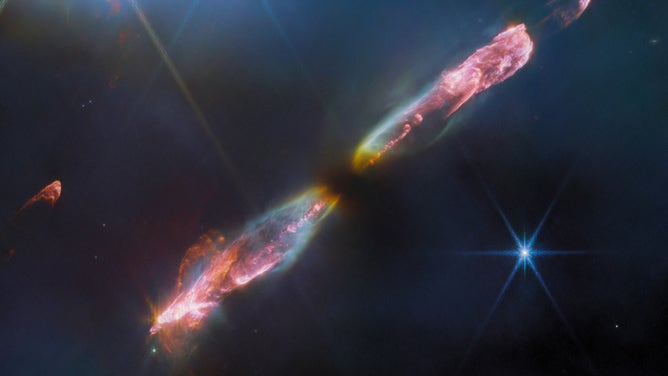Baby star's supersonic outflow captured in stunning detail by Webb telescope
This image of Herbig-Haro object HH 211 has five to 10 times the spatial resolution of any previous image of it.
What is the James Webb Space Telescope?
According to NASA, the JWST sees the universe using infrared radiation, a form of light that we feel as heat and is invisible to human eyes.
The James Webb Space Telescope captured the supersonic outflow of a young star in stunning detail.
The image of a Herbig-Haro object called HH 211 has five to 10 times the spatial resolution of any previous image of it. It shows the newborn star spewing jets of gas that travel at 48-60 miles per second, according to researchers. JWST's infrared sensors mapped out the shockwave formed when the jets collided with nearby gas and dust at high speed.
WEBB DETECTS POSSIBLE SIGNS OF LIFE ON DISTANT PLANET
"Molecules excited by the turbulent conditions, including molecular hydrogen, carbon monoxide, and silicon monoxide, emit infrared light that Webb can collect to map out the structure of the outflows," NASA officials said in a statement.
The arching shapes at the bottom-left and top-right of the image below are called bow shocks, named for how they resemble the bow of a boat.
SEE THE ‘WHIRLWIND’ OF IMAGES TAKEN DURING JAMES WEBB SPACE TELESCOPE'S FIRST YEAR

NASA’s James Webb Space Telescope’s high resolution, near-infrared look at Herbig-Haro 211 reveals exquisite detail of the outflow of a young star, an infantile analogue of our Sun. Herbig-Haro objects are formed when stellar winds or jets of gas spewing from newborn stars form shock waves colliding with nearby gas and dust at high speeds The image showcases a series of bow shocks to the southeast (lower-left) and northwest (upper-right) as well as the narrow bipolar jet that powers them in unprecedented detail. Molecules excited by the turbulent conditions, including molecular hydrogen, carbon monoxide and silicon monoxide, emit infrared light, collected by Webb, that map out the structure of the outflows.
(ESA/Webb, NASA, CSA, Tom Ray (Dublin) / NASA)
"Researchers have used Webb’s new observations to determine that the object’s outflow is relatively slow in comparison to more evolved protostars with similar types of outflows," researchers said of the baby star.
NASA stated that this protostar will eventually grow into a star like the Sun.
"This image of HH 211 from NASA’s James Webb Space Telescope reveals an outflow from a Class 0 protostar, an infantile analog of our Sun when it was no more than a few tens of thousands of years old and with a mass only 8% of the present-day Sun," researchers said.
